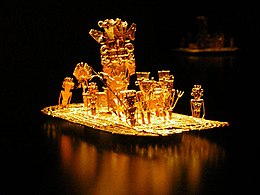| Siecha Lakes | |
|---|---|
 Siecha Lakes, from left (east) to right (west) Siecha, Guasca, De los Patos | |
| Location | Guasca, Cundinamarca |
| Coordinates | 4°45′52″N 73°51′04″W / 4.76444°N 73.85111°W |
| Type | Glacial |
| Part of | Chingaza Natural National Park |
| Basin countries | Colombia |
| Surface area | 141,401 m2 (1,522,030 sq ft) [1] |
| Max. depth | 25 m (82 ft) |
| Surface elevation | 3,590 m (11,780 ft) [2] |


a similar raft was found in Lake Siecha but lost due to fire of the ship in the harbour of Bremen
The Siecha Lakes are three glacial lakes located in the Chingaza Natural National Park in Cundinamarca, Colombia. The Andean lakes are considered sacred in the religion of the Muisca who inhabited the area before the Spanish conquest of the Muisca in the 1530s. [3]
Etymology
In the Chibcha language of the Muisca Siecha means "House of the Lord". [4]
Description
The Siecha Lakes consist of three small glacial lakes, from large to small and east to west; Siecha (63,893 m2), [1] Guasca (56,846 m2) [1] and De los Patos (20,662 m2). [1] Alternative names for the smaller two are Fausto and America. [4] The lakes belong to the municipality of Guasca. Fauna around the lakes are the birds American purple gallinule, helmeted curassow, torrent duck, Andean cock-of-the-rock, eagles and orange-fronted parakeet. In the lakes the birds Oxyura jamaicensis andina, Andean teal and the American coot can be found. Mammals around the lakes include the spectacled bear, white-tailed deer, red deer and the little red brocket. [4]
History
In the colonial period, the lakes were partly drained to extract the golden artefacts of the Muisca from the water. In 1855 a golden raft was found in one of the lakes, similar to the famous Muisca raft. It was named Balsa de Siecha or "Siecha raft" and pictured in the book El Dorado by Muisca scholar Liborio Zerda in 1883. The discovery of the raft made Zerda believe that the site of the initiation ritual of the new zipa was not in Lake Guatavita, yet in the Siecha Lakes. [5] Later, the raft was more-or-less legally taken from Colombia to Europe. The transporting ship burnt in the harbour of Bremen and the raft was lost. [4]
Tourism
To visit the lakes certain rules apply; visits are only possible on Saturdays and Sundays, access at the entrance point needs to be not later than 10:00 AM and exit not after 4:00 PM. A maximum of 30 visitors per day is allowed. [4]
See also
References
- ^ a b c d Google Maps Area Calculator
- ^ Google Maps Elevation Finder
- ^ Ocampo López, 2013, p.213
- ^ a b c d e (in Spanish) Description of the Siecha Lakes
- ^ Guarín Martínez, 2005, p.239
Bibliography
- Guarín Martínez, Óscar. 2005. De bárbaros a civilizados: la invención de los muiscas en el siglo XIX - From brutals to civilised: the invention of the Muisca in the 19th century, 228–246. Universidad La Javeriana.
- Ocampo López, Javier. 2013. Mitos y leyendas indígenas de Colombia - Indigenous myths and legends of Colombia, 1-219. Plaza & Janes Editores Colombia S.A..
External links
- (in Spanish) Hikes to the Siecha Lakes

